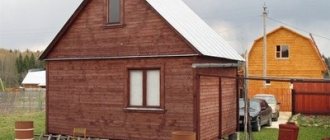Land plots differ not only in category and permitted use, they have different limit values established by legal acts taking into account urban planning regulations.
The maximum and minimum size of plots is provided for all types of permitted use , including private farming.
If the area of the new or allocated plot is not included in this range, then it will be impossible to register ownership of it. Buildings erected there will also be considered illegal.
The differences in the established maximum values of private plots in different subjects are explained by different population densities, the ratio of used and vacant territories, the direction of development of these territories and the demand for private plots.
The legislative framework
Is it possible to register for private household plots?
As in all other cases, this is regulated by the federal Rules for registration and deregistration of citizens. But when obtaining a “residence permit” in the suburbs and rural areas, there may be some nuances .
The amount of time and hassle spent on registration will primarily depend on the category of land on which the building is located. If it is located in a village or hamlet that has been on the map for a long time , unnecessary problems should not arise.
Until January 2014, heads of village councils and village administrations could register the residence of citizens in private houses.
But some paragraphs of the law “On Amendments to Certain Legislative Acts of the Russian Federation,” popularly known as the “Law on “Rubber” Apartments,” marked the assignment of this responsibility to the territorial structures of the Federal Migration Service of Russia.
Find out from our articles whether it is possible to register in a hostel or apartment, and also what to do if there is nowhere to register.
Is it possible to register in LPH in 2021?
If a citizen owns a home as a shared owner, he can also register in part of the house. The relevant registration documents do not indicate the entire house, but only the share owned by the citizen. If a part of the housing owned by a citizen is isolated from other parts (it has its own supporting structure, entrances and exits), then he has the right to register in it without the consent of third parties. If part of the house is not isolated, then it is necessary to obtain written consent from the other owners of the house. Please note that this rule does not apply to persons under 18 years of age, who can obtain registration in their parents’ living space without the consent of third parties.
When is registration without ownership applied? At the birth of a child, he must be registered at the place of registration of one of the parents. In this situation, the consent of the property owner is not required. But to prevent property disputes from arising in the future, the child is registered without ownership rights.
So, a personal plot is a plot of land that is for personal use. Moreover, it can be either house or field. If you want to equip and erect the necessary buildings, you should clearly understand that you can build anything you want on your personal plot, but it is important to properly legitimize these buildings so that no problems arise in the future. On this issue, it is better to contact a cadastral engineer. Without restrictions, buildings for personal use and needs are erected here, such as residential buildings, premises for household needs, etc.
Much in this matter depends on local governments and on how much they understand the legislation and know how to interpret it. It is worth realizing that buildings erected on field private plots will not have a postal address in any case. As for drilling wells, the situation is the same as with private household plots.
What is a personal subsidiary plot (LPH)
Personal subsidiary farming (LPH) is a form of non-entrepreneurial activity for the production and processing of agricultural products. The activity is carried out by a citizen or a citizen and members of his family living together with him and (or) jointly carrying out personal farming with him in order to satisfy personal needs on a land plot provided and (or) acquired for running personal farming.
Law No. 112-FZ of July 7, 2003 was adopted for owners of personal subsidiary plots and regulates all types of relations that arise in the process of organizing and maintaining private household plots. I recommend that you read the Law in detail - it is small in volume, clearly stated and clarifies a lot.
The Federal Law on personal subsidiary plots contains sections:
- concept of private household plots;
- rights of citizens in the organization and management of private household plots;
- land plots for private household plots;
- relations between government authorities at all levels and owners of private household plots;
- property when running private household plots;
- legal relations with the Pension Fund of the Russian Federation;
- accounting and termination of activities.
If you don’t have time to read this bill, then here’s how I understood this law:
- Personal subsidiary farming is an activity that is not considered entrepreneurship, despite the fact that the products grown are considered the property of the owner and can be sold. Since the activities of private household plots are related to agriculture, it is most appropriate to compare this form with a peasant farm (peasant farm).
- Our plot is only 20 acres, there are several fruit trees near the house, we have planted a vegetable garden and raise a dozen chickens. We are not planning to expand yet, but even if someday there is a desire to sell what we have grown, this type of activity will not be considered entrepreneurship. According to the law, private household plots are classified as non-profit activities if members of the same family are employed in them.
What is the difference between private household plots and individual housing construction
Legal sale of products
According to the Federal Law on Personal Subsidiary Farms, the sale of products produced on the lands of private household plots does not relate to entrepreneurial activity.
You can sell your products grown on the site in markets , as well as by concluding a cooperation agreement with restaurants, cafes and other catering establishments. But to do this, it must undergo a certain examination for compliance with standards, and with ready-made documents and certificates in hand, the owner of the product can sell it for use by other people.
- documents confirming compliance with the mandatory requirements of regulatory documents (copies of the certificate or declaration of conformity);
- veterinary accompanying documents: veterinary certificate form No. 2 (for transportation from another region (city);
- veterinary certificate form No. 4 or a stamp of the state veterinary service in the shipping document (for transportation within the district (city);
- for meat, in addition to the above: the conclusion of the state laboratory of veterinary and sanitary examination, allowing the sale of meat on the market.
To protect yourself from the persistent attention of the Tax Service, you need to obtain a document from the local administration stating that this particular product was produced in this particular area. Next, it is advisable to register the private household plot in the household register.
To do this, indicate:
- Full name, date of birth of the owner of the land plot, as well as the full name of all family members living with him.
- Number of animals, bees or birds present.
- The area of land occupied by crops or plantings.
- the number of units of agricultural machinery and vehicles involved in the processing and creation of products.
You can find out more about how to open a private household plot and what taxes the owner expects here.
Differences from individual housing construction
Private household plots and individual housing construction have significant differences that allow plots to be divided into these two types. Private household plot is land that can be located not only on the territory of a populated area, but also outside it. This fact regulates the possibility of building houses on the territory.
Individual housing construction is land that was originally intended for the construction of residential premises. If the house is built on individual housing construction, then all communication infrastructures available to any other resident of the locality are guaranteed to be connected: electricity, gas, schools, libraries, kindergartens, shops, and so on.
The next difference is the right to a tax deduction. The parameter is regulated using the Tax Code of the Russian Federation. According to the Tax Code of the Russian Federation, if a house is not built on the land within ten years, then the territory will be taxed at a double rate. Private household plots have an advantage over individual housing construction in this case due to the reduced initial tax rate.
Registration is possible only in the house that is located on the territory of the locality. Housing is recognized as suitable for registration and residence only after the project is put into operation and registered in the state register.
Plots of land for private plots and individual housing construction - what is the difference between them
Thinking about purchasing a plot of land? Then you will definitely come across such a concept as “type of permitted use”. This determines not only what the owner can do on the site, but also its cost. The optimal solution for those who want to acquire their own cottage is the land of individual housing construction and private subsidiary plots. Which option should I choose? What are the differences? So that every buyer can weigh the pros and cons before concluding a transaction, let’s try to understand the features of such land.
Private household plots are plots that can be obtained by citizens who want to grow vegetables, berries and fruits, raise livestock and birds. When purchasing real estate with this type of RI, it should be taken into account that in accordance with the norms of the Law of the Russian Federation of July 7, 2003 No. 112-FZ, private household plots are of two types:
Is it possible to build a residential building on the lands of private household plots?
I bought a plot with a built house, but I completed some things on it myself: greenhouses, a bathhouse, a workshop. To avoid misunderstandings with a building permit, I had to study the legislation in detail, and at the same time found out whether it was possible to build a house on the lands of private household plots. Briefly about the most important things.
A plot of land for private plots can only fall into two categories:
- Land for a personal plot within a populated area. On a private plot of land, you can build a residential building and any other buildings (subject to the rules that are the same for everyone - construction, fire safety, sanitary and hygienic and others, and you can also produce agricultural products (any kind: planting plants, raising animals and poultry, setting up an apiary) In a residential building built on a private plot of land, you can register at your place of residence, and it is also possible to receive a property tax deduction.
- Field land for growing crops. On a field plot of land, you can only produce agricultural products and erect non-permanent buildings for this purpose (without a foundation). It is prohibited to build a residential building, and if it is built, it may be forced to demolish it. Naturally, there is no question of registration in such a house.
Rights and obligations of the owner
Owners of private household plots have the following rights:
- Inherit and bequeath.
- Create an individual entrepreneur and register other legal entities.
- Make transactions that do not contradict the law.
- Have property and personal non-property rights.
- Erect houses, buildings, structures, structures (within the framework of the law on this type of economy). You can find out more about what is possible to build on the lands of private household plots and for the construction of which objects a permit is required here.
- Fence the area to prevent third parties from entering it.
Responsibilities:
- Do not cause damage to the earth and the surrounding nature.
- Make payments on time and in full.
- Maintain real estate on the site in accordance with architectural, planning, construction, environmental, sanitary and hygienic, fire safety and other established requirements, norms, rules, regulations.
- Use the land plot for its intended purpose for 3 years.
What does registration of private household plots give?
The law states that state support is one of the components of running private household plots.
Help includes:
- organizing infrastructure and facilitating the creation of cooperatives that will help in the maintenance, processing and marketing of products;
- creating conditions for development (we are talking about interest-free loans and equipment rental);
- carrying out various activities to improve the meat qualities of animals;
- organization of animal insemination;
- free inspection of livestock by veterinarians.
But regardless of whether the state decides to support the activity, small landowners initially feel the advantages of running such a business.
Advantage 1. Possibility of selling products
Owners have the right to freely sell surplus vegetables, fruits, meat, etc. The only condition is that only family members can be involved in growing and caring for plants and animals.
Private household plots as a business idea for beginners - a detailed article to delve deeper into the topic.
Advantage 2. No taxes!
Private household plots are not registered with the tax authorities, that is, they are exempt from reporting. Accounting is carried out by local authorities, entering information into the household ledger provided exclusively by the owner. The only mandatory tax is on land.
Advantage 3. Opportunity to take part in the state support program
Subsistence farming is subject to state support, prescribed in the legislative framework for agricultural producers. For such assistance, money is allocated from the budgets of the Russian Federation at different levels.
Government agencies also develop and implement programs to simplify the management of private household plots.
How to get a loan for private household plots or a grant for agricultural development - read in special articles.
Advantage 4. Protection from unexpected visits from sanitary services
In Art. 4 clause 2 of Law No. 112-FZ states that land provided by the state must be used in compliance with sanitary and hygienic standards. At the same time, there is no law regulating the right to organize inspections by sanitary services.
Is it possible to register in LPH in 2021?
- Certificate of ownership.
- Extract on the ownership of the plot.
- Technical passport from the Architectural Inventory Bureau.
- Extracts from the cadastre for land and house.
- Examinations of sanitary and fire services.
- A justified refusal by the administration, formalized in accordance with all the rules.
- Heating . Provided by boiler or furnace.
- Water supply . There may be a central water supply or a separate well. If there is only imported water, this will become an obstacle to obtaining individual housing construction status.
- Electricity . Without this system, it is not possible to make a dacha a residential property.
Is it possible to build a house and register for private household plots?
The construction of a residential building on a private plot is allowed only if it belongs to a populated area. If a personal subsidiary plot is located in a field, the owner does not have the right to erect such buildings on it.
The law prohibits starting construction without obtaining permission from the local administration. However, before contacting the municipality, you will need to determine a location for future construction that meets sanitary standards.
If you ignore the requirements of the law and build a house without obtaining permission from local authorities, in the future it will be possible to legalize it in most cases only through the court. This requires additional costs and is not always possible
. If violations are detected, the court will order the building to be demolished.
Step 1. Obtaining a building permit
A building permit is issued by an authorized person based on the following documents:
- application for a building permit;
- a document confirming the existence of property rights to the site - an extract from the Unified State Register of Real Estate, a certificate of ownership, etc.;
- urban planning scheme of the land plot;
- a schematic representation of the site layout indicating the location of the future building;
- a detailed description of the appearance of the future residential building, if the territory is historically significant.
The package of papers is submitted to the authorized department of the municipality or MFC. After consideration, a construction permit or refusal document will be issued, which sets out the reasons for such a decision.
.
The landowner has the right to correct shortcomings and submit the papers again
. If the refusal is unlawful, it can be challenged in court.
It is prohibited to start construction without obtaining permission. Only after receiving a permit can work begin.
Step 2: Commissioning
After the house is built, you must contact the municipality again and write an application to put the building into operation. A commission will visit the site to check whether the house complies with sanitary and construction standards
. If everything is in order, the citizen will receive permission to put the house into operation and technical documentation from the BTI.
If inconsistencies are identified, the commission will give time to eliminate them. After adjustments, you need to apply again and obtain permission to put into operation.
Rules and regulations
The concept of limit values is used in the Town Planning Code of the Russian Federation.
They are determined by town planning regulations along with other parameters of permitted construction:
- the maximum permitted percentage of development,
- necessary distances from boundaries to buildings,
- permitted number of floors and height of buildings.
The established limit values depend on the VRI, for example, for individual housing construction plots the established areas are smaller than for private household plots and peasant farms. To determine these values on the lands of settlements, not only land and urban planning legislation, but also the Rules for Development and Land Use are taken into account.
In the absence of approved PZZ, the limit values are determined by the local administration in its legal acts (clause 4 of Article 4 of the law on private household plots).
For plots located on federal lands, the permissible range of area should be determined by federal laws , and for plots on the lands of a subject - by regional laws .
A maximum of 0.5 hectares of private household plot land may be owned or otherwise held by a citizen . This value can be legislatively increased at the subject level, but no more than 5 times (clause 5, article 4 of the law on private household plots).
The established maximum values apply to all land plots, with the exception of
- granted ownership,
- rent
- or free use
on the basis of Law No. 119-FZ.
If a land plot was received for indefinite use, inherited lifelong possession
before the adoption of the law on private household plots, or received as a result of donation, inheritance, purchase and sale, then the established limits of the permitted area do not apply .
Ownership rights can be registered for such plots.
In some regions, when registering ownership of a plot with an area exceeding the permitted maximum, the purchase of “extra” acres is required.
Registration in a house on a private plot
Regarding private plots, in accordance with Law No. 112-FZ, a personal plot of land can be used for the production of agricultural products, as well as the construction of a house. This means that you can also register on your private plot, but to do this you need to register the rights to the house, after which you must contact the district administration with an application for assignment of a postal address. After this, it is necessary to make the appropriate changes to the Unified State Register and State Property Committee regarding the address and obtain an updated certificate with the address of the house. Registration on a plot of private household plots in the absence of a house is impossible.
In order to register, you must meet the following requirements:
- Provide evidence that the house on the private plot is the only possible place of residence;
- A house built on a private plot must be recognized as capital - i.e. be suitable for living all year round;
- Access roads must be built to the construction to allow vehicles to access the site.
Thus, having just a house with an address may not be enough to obtain registration in it.
Registration in an unfinished house and on a plot without a house
Please note that you cannot register in an unfinished house only in the following cases:
- The premises cannot yet be used for living; construction work is being carried out on the main elements of the house - walls, roof, foundation, etc.
- There are no engineering systems, electricity supply, water supply, etc.
- The land on which the house is located is used only for agriculture.
If the house is found suitable for living, i.e. will meet the requirements for residential premises, then registration in it is possible. In order to recognize a house as suitable for habitation, it is necessary to contact the state authority of the subject or local government. Then a special interdepartmental commission will be created, which will decide whether the premises are suitable or unsuitable for living.
Registration on a site where there is no house is impossible, since according to current legislation, there must be a house that is recognized as suitable for living and meets the requirements for residential premises.
It is possible to register in a private house, regardless of the type of plot on which it is located, if you have the necessary documents and confirmation that such a house (even unfinished) is suitable for habitation.
How to get loans?
Like any business, running private household plots requires serious financial costs : purchasing equipment, constructing premises, purchasing animals for breeding, etc. There may not be any free finance available to a citizen. In this case, the bank can come to the rescue. In order to receive a loan, the following conditions must be met: the client must be a citizen of the Russian Federation and already own the land plot on which the farm is run.
To draw up a contract you need:
- citizen's identity document;
- questionnaire and application;
- extracting their household register;
- military ID (for men under 27 years old);
- documents confirming employment and solvency;
- documents on the security provided (collateral);
- invoices, checks, payment documents indicating the intended use of the funds received (payment for services, purchase of goods, equipment, livestock, etc.).
The loan is given for a period of 2 to 5 years.
Registration procedure
You must first be discharged from your previous place of residence and receive a so-called departure certificate, and for men of military age, deregister with the military registration and enlistment office (you can find out how to register at a new place, and whether you need to be discharged for this, in our article). In addition, a package of the following documents will be required for presentation to the Federal Migration Service:
- a written application for registration on the form of the migration service (it can be obtained directly upon application or downloaded from the official website of the feds);
- documents for ownership of real estate . If the house does not belong to the person who wishes to register in it, it is necessary to obtain the written consent of the owner or a court order on the right of residence;
- a citizen's identity card, and for minor teenagers under 14 years of age - a birth certificate.
It will also be necessary to present the house (household) book available to the owners.
The procedure for providing plots
The provision of plots for organizing subsidiary farming requires citizens to contact the legislative authorities, where the procedure for reviewing applications, checking and preparing documents will take a lot of time for recipients of land plots.
Step-by-step instructions will help you decide on the procedure for obtaining:
- Part of the time in starting any land transaction is spent on preparing documents, which must be provided in advance, taking into account all the above information.
Copies of the passport, various certificates and confirmations must always be in several copies and provided along with the originals.For different categories of persons there is a special list of documents provided for obtaining a land plot. The main ones include:
- passport;
Marriage certificate;
- children's birth certificates;
- certificate of family composition;
- a certificate received from the building management regarding the meters of living space;
- extract from the house register;
- a certificate from Rosreestr confirming the absence of land plots;
- documents providing various benefits.
- When the documents are prepared, they can be attached to an application signed by the citizen, which is drawn up in the name of the head of the administration in the region where the land is expected to be allocated.
The application is drawn up in the form of a request for the allocation of territory indicating its intended purpose.The application is signed and left at the reception until it is reviewed.
- After a 30-day waiting period for a decision, the citizen is informed about the positive or negative outcome of his case. In any case, the interested person receives a written decision to provide the site or a written reasoned refusal.
- The next stage involves establishing the boundaries of the land plot (land surveying), which is carried out by local authorities on a certain day established by the administration, after which a resolution is issued on its implementation.
- A new step is to contact the cadastral department, which provides for the registration of the land plot, the issuance of a passport for the land, as well as diagrams and drawings of the site.
The duration of such a procedure is limited to a one-month waiting period and 6-7 thousand rubles, which will need to be paid for the production of documents. - The documents received from the cadastral authorities return the procedure to the local executive authority, where a document is issued for a freely provided land plot or an agreement stipulated by law is concluded with conditions depending on the category of citizens who applied.
The agreement contains main sections, which include various subclauses. The main articles of the concluded agreement for the provision of land plots for private household plots are:- date and place of signing;
the name of the entities that entered into the transaction;
- name of the rental object;
- property;
- insurance;
- period of validity of the contract;
- rights and obligations of the parties;
- purpose of the allotment;
- Terms of Use;
- significant restrictions on land use;
- conditions and terms of transfer of land for use;
- liability of the parties;
- force majeure;
- final provisions;
- address details of the parties with signatures.
- Documents received within the executive branch are registered by Rosreestr.
We do not recommend completing the documents yourself.
Save time - contact our lawyers by phone: 8 (800) 350-29-87 Moscow
Attention! The resolution provided by the administration must contain information about the exact location of the allotment, as well as the parameters of the allocated land area.
Now let's talk about in what cases the allocation of territory may be refused.
Timing and cost
It remains to add that all of the above papers must be submitted to the registration authorities within a week from the moment of moving.
The processing time for a passport with a mark on the new registration should not exceed three days.
Just 11 years ago, for such a new stamp, citizens of the Russian Federation paid the state a fee in the form of one percent of the minimum wage.
Today, obtaining permanent residence for Russian citizens costs nothing. The state fee for registration in the Russian Federation in the amount of 350 rubles is paid only by foreign nationals and stateless persons.
How to register at a dacha or SNT in 2021
Citizens can be registered at their place of residence. According to paragraph 1 of Art. 20 of the Civil Code of the Russian Federation, such a place is recognized as a premises intended for permanent residence. This could be an apartment, a room, a residential building. This does not take into account the ownership of this premises and the intended purpose of the land plot where the residential building is erected.
Registration at the place of residence or temporary stay is associated with the possibility of employment, attachment to a clinic, preschool, educational institutions, etc. It is possible to register in any residential premises where a citizen permanently or primarily resides, including in a house located in SNT.
- Urban development plan of the land plot (provided free of charge).
- For some regions of the Russian Federation, additional topographic survey of the plot is required.
- Scheme of planning organization of a land plot.
- Technical plan of a residential building.
Local authorities do not have the right to refuse to issue a construction permit if the conditions and procedure for obtaining comply with the law. The Town Planning Code provides an exhaustive list of possible grounds for refusal of construction, as well as a list of documents for obtaining permission.
From the date of submission, 10 days are allotted to study the papers and issue a permit for construction work. The validity period of the received document is 10 years. Its power remains even in a situation where the owner changes. This is due to the fact that the document is linked to the site, and not to the person.
The first step to acquiring a residence permit at a dacha will be an individual consideration of the question of whether it is possible to register at a dacha plot, which includes comparing all the factors of an existing dacha house with the required parameters of a residential building suitable for habitation. It is necessary to obtain evidence that the dacha is a residential building and provide it to the court.
Refusal of registration
Is it possible to register on agricultural land? It’s good if the hacienda is fully equipped for living , has all the communication infrastructure and official confirmation of readiness for use. And most importantly, it is located on the right land.
But often the desire to save money leads to the purchase of a house in which it is not only impossible to live, but also impossible to register .
Such precedents usually arise where real estate was originally built on agricultural land, on summer cottages.
But there is still an opportunity to obtain registration in the village - you just need to prepare for a long “siege” of various authorities, including the courts , and the inevitable financial expenses for conducting examinations .
Is it possible to register in LPH in 2021?
Previously, dachas were not classified as suitable for all-season living. Owners were not registered in them. But more and more citizens are choosing such buildings not only for summer, but also for winter, which was the impetus for the development of the corresponding bill
An object with external walls and a roof, a reliable foundation. Protection from cold, wind and precipitation is taken into account. The home should be safe and comfortable. Engineering communications are also required, which allow you to live in the country all year round. The presence or possibility of carrying out:
Suitability for habitation
If previously there was an unconditional taboo on the registration of citizens in buildings located in dacha areas, then the Resolution of the Constitutional Court of the Russian Federation of June 30, 2011 No. 13-P does not exclude a loophole for those who wish to register on their garden plots, even if they belong to the category agricultural land .
You just need to document that your house or cottage is completely suitable for habitation .
It looks like this. First, the owner appeals to the territorial body of the Federal Migration Service with an application for registration.
And with a high degree of probability, they will be refused there, on the grounds that the dacha building is intended for seasonal and not permanent residence.
But now the citizen has a reasoned reason to file a claim, and the court may well recognize the decision of the FMS as illegal and the dacha building as suitable for habitation .
To do this, you just need to prove a few important circumstances. The land and buildings on it must be the personal property of the plaintiff, and the house must be his only refuge (if there is another registration, he will have to part with it).
The building must be considered residential, that is, fall under the definition of “individual residential building”, which appeared in Russian legislation in 2013.
This last requirement is decisive and, in turn, depends on a number of documented conditions.
Firstly, there must be a construction expert confirming the possibility of year-round living, the presence of a solid foundation, intact and thermally insulated walls, a communications system and protection from water.
Secondly, the land on the site must be used exclusively for gardening , and the building must be located in a populated area with appropriate social infrastructure, have a postal address and be listed in Rosreestr as a real estate property.
If all these circumstances in the case are thorough and proven, and the court deems it necessary to satisfy the citizen’s claims, he will calmly be able to register the right to reside in his country house.
It remains to add that all of the above applies to registration of rural registration for private household plots .
If the house (taking into account all construction requirements) is built on a personal plot, that is, belonging to settlement lands, court intervention is not required.
If it is located outside the populated area, then it falls into the category of agricultural land , with all the ensuing consequences. In any case, good luck and happy housewarming!
Private household plots or individual housing construction: the difference, differences and subtleties of choice
The intended purpose of each specific plot is indicated in the cadastral document. Accordingly, it is determined even when the site is allocated.
If we are talking about the boundaries of a populated area, then there are no fundamental differences between a personal plot and a plot for housing construction. They are subject to exactly the same urban planning rules.
But the differences and differences between the field site for private household plots and the individual housing construction site are obvious - on the first one, the construction of capital buildings is impossible, and it is located outside the boundaries of the settlement, which in Russian conditions can mean tens of kilometers from the nearest city or village.
Most often, field plots are allocated to all kinds of SOT, SNT and other associations of summer residents. Accordingly, all issues with the supply of communications, registration of property rights, and land use are resolved by the administration of the associations or the general meeting. Considering Russian realities, farming on such a site is often a very problematic issue.
Another difference may lie in taxation considerations. Thus, sometimes the cadastral value of a plot for private household plots (if we are talking about a field plot, then most often) is lower than that of a plot for individual housing construction. Accordingly, the tax amount will be less.
How much does it cost to register a will with a notary? See the link for the answer.
When choosing a site, it is always necessary to take into account local realities. For example, a situation cannot be ruled out when the plot for private household plots may be larger in area than the plot for individual housing construction. Accordingly, the acquisition of a plot for private household plots allows you to slightly increase the maximum land area, which for individual housing construction can be strictly limited.
As for the sale price of a plot, a plot for private household plots is often cheaper, but there may be pitfalls. Sometimes, even in a populated area, restrictions on construction are expected due to nearby communications or for other reasons. If they exist, then this must be indicated in the cadastral passport of the site.
Therefore, the choice of a site within the city for private household plots should be taken responsibly, carefully study all cadastral documents, issues of the availability and possibility of connecting utility networks and local features.
Pros and cons of registration, possible difficulties
Registration in private household plots has some pros and cons that you should be aware of.
Pros:
- simple organization - no legal registration required;
- The tax office also does not require mandatory registration;
- such land is subject to various benefits;
- the owner himself decides whether he needs to replenish the Pension Fund with money or not.
Minuses:
- the size of the land should not exceed half a hectare;
- the site is deprived of preferential loans, subsidies, etc.;
- Some types of certified activities are prohibited here.
So, you can register on the territory of a personal subsidiary plot if the building complies with existing living space standards. Sometimes such registration can only be real by a court decision. If no other options exist, this method is the way to go.
Veterinary, sanitary and other standards for content
Birds
Veterinary rules for keeping poultry were approved by order of the Ministry of Agriculture of the Russian Federation dated April 3, 2006 No. 103.
Different types of poultry should be housed in different areas of the building . Walking areas for different types of birds should be individual. Made from materials that can withstand cleaning and disinfection. Floors must be durable, durable and made from materials that are resistant to constant drainage and disinfectants. Ventilation must be provided to create an optimal microclimate in the premises for birds.
Veterinary and sanitary procedures:
- The premises must be washed regularly, and equipment (feeders, perches, drinking bowls) must be disinfected.
- The bedding material in the premises should consist of sawdust, wood shavings, etc. The use of frozen, moldy, or damp bedding material is prohibited. It is usually laid on a layer of lime - fluff 10-15 cm thick.
- Windows and doors are equipped with frames with mesh to prevent wild birds from entering the premises.
- It is recommended to work with poultry in clean overalls and shoes.
Pigs
Veterinary rules for keeping pigs were approved by order of the Ministry of Agriculture of the Russian Federation dated March 29, 2021 No. 114.
- It is necessary to provide the area with a fence to prevent other animals from entering. With a livestock of 5 heads, the minimum distance from the corner of the pig-breeding premises to the border of the neighboring plot should be at least 10 meters, with 15 heads - at least 40. For a certain type of pig, it is necessary to provide a certain area m2.
- Disinsection, decontamination and deratization of pig-breeding premises are carried out at least once a year.
- Feed must be heat treated for at least 30 minutes after boiling.
- Drinking water must be used as food for animals.
- Pigs kept on farms are subject to diagnostic tests, vaccinations and treatments against infectious diseases in accordance with the Epizootic Action Plan.
Cattle
The rules for keeping cattle are regulated by order of the Ministry of Agriculture of the Russian Federation dated December 13, 2021 No. 551.
- The food must meet veterinary requirements. The stock of feed should be kept in the amount required for each head for 30 days in advance. Milk – for 1 day. Powdered milk - for at least 15 days.
- Hay, straw, silage, etc. – for 1 stall period.
- For drinking, you must use clean drinking water.
- Pastures must be located at least 2.5 km away. from a watering hole.
- Cattle must be housed in sections or stalls. The sections must be arranged in such a way as to ensure unhindered exit from them. Different types of cattle need to be kept in different rooms (of the same or different buildings).
Advantages of personal subsidiary farming
- Simplicity of organization (LPH does not require legal registration);
- lack of registration with the tax office and tax reporting (accounting is maintained in household books by local authorities based on information provided by the owners);
- various benefits (exemption from personal income tax under certain conditions, preferential transport tax on equipment, etc.);
- the possibility of making an independent decision on pension insurance (the owner of a private household plot decides whether to pay contributions to the Pension Fund).
Summer residents' rights
Even if the owner of a plot on the territory of SNT is not a member, he can still participate in the meeting. Such gardeners may not vote on all issues, but they have every right to take part in the meeting and express their opinions. Both members of the SNT and those owners of plots who are not members of the partnership should be freely allowed to the place where the general meeting is held.
To register ownership of a dacha plot with Rosreestr, it must be issued for the purposes of vegetable gardening or horticulture. You will need a document that confirms this: a state act or a land certificate. It could be a worn yellow piece of paper that is kept in grandma's chest. You need to contact Rosreestr with the document, write an application and pay the state fee - 350 RUR. All this can be done through the MFC.
13 Aug 2021 semeiadvo 71
Share this post
- Related Posts
- How to receive a lump sum benefit for the birth of a child in 2021
- If There Is No Place in Kindergarten Is Compensation Entitled in 2021?
- Experience for a labor veteran in Chuvashia in 2021
- Transport tax benefits in the Nizhny Novgorod region in 2021
conclusions
Thanks to the import substitution program, private household plots have received a new round of development. Farming is now carried out not only by rural residents, but also by some urban residents and even the oligarchy. For example, the former mayor of Moscow Yuri Lushkov also took up agriculture - he grows buckwheat in the Kaliningrad region.
In the first half of this year, the volume of agricultural products in Russia increased by 3%, despite a general fall in GDP. Facts and figures create a favorable background for reducing loan rates and guaranteeing demand for the products of private farms in the future.
Sources
- https://pravovoy-standart.ru/gilishnoe-pr/nedvigimost/kvartira/propiska-kv/postojannaja/mesto-reg/v-derevne-i-sele.html
- https://zembaron.ru/investiczii/kak-oformit-lpx-i-nachat-zarabatyivat-s-nulya/
- https://1kvartirka.ru/propiska-v-lph/
- https://startapoff.ru/businessmen/kak-oformit-lph
- https://bupum.ru/protsedura-propiski-v-lph
- https://www.landatlas.ru/kategorii-zemel/izhs/propiska-v-individualnom-zhilom-dome.htm
- https://mestozhitelstva.ru/propiska-v-lph-mozhno-li-propisatsya-na-uchastke/
Pension insurance
Article 9 of Federal Law No. 112-FZ dated 07/07/2003 grants citizens with the right to voluntarily enter into legal relations for compulsory pension insurance in accordance with the legislation of the Russian Federation.
Since January 2013, amendments to Article 29 of Federal Law No. 167 “On Compulsory Pension Insurance in the Russian Federation” came into force on the right of owners of private household plots to make contributions to the Pension Fund of at least 150 rubles per month. This will allow you not to be left without a pension when the time comes. It will be unfair: a person works by the sweat of his brow in agriculture, the state does not know about this, and by the time the person is left without support due to old age. The above-mentioned law allows you to avoid such situations.
Getting permission
A building permit is not required when registering the right to a house, but it is still better to obtain one. The Town Planning Code of the Russian Federation (Parts 1 and 2 of Article 51) still provides for the need to build only with a construction permit, and the Code of Administrative Offenses (Part 1 of Article 9.5) establishes liability for the construction of a capital construction project without permission.
A violator, an individual, is subject to a fine of 2 to 5 thousand rubles, and such a fine can be imposed repeatedly throughout the entire construction period.
To obtain a construction permit, an application for a permit and three documents accompanying it are submitted to the local administration:
- title document for land;
- urban planning plan of the site, it must first be obtained from the same administration by writing an application for issuance, the administration collects documents for registration independently, the urban planning plan is issued free of charge within thirty days from the date of submission of the application;
- a planning organization diagram, which is prepared by the developer to the best of his ability - usually the proposed development scheme is drawn with a pen on a copy of the cadastral plan.
If these three documents are available, a building permit is issued no later than 10 days after submitting the application.
Advantages and disadvantages of private household plots
Advantages:
- maintaining private household plots is not a business activity, that is, registration of an individual entrepreneur is not required;
- there is no need to pay income tax (NDFL) if the following conditions are met: the size of the plot is not larger than that established by law;
- Only family members work in private household plots; hired labor is not used.
Flaws:
- The combination of a high rate of land tax on private plots within the boundaries of a populated area and a ban on the construction of residential buildings on private plots outside such boundaries. That is, everyone faces a choice: either it is prohibited to build, or high taxes.










